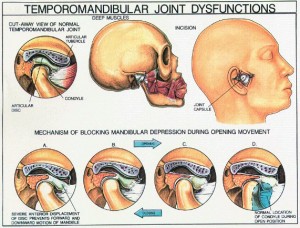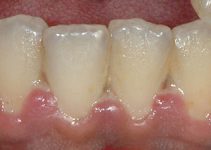TMJ or Temperomandibular joint is the joint that connects the jaw bone to the temporal bone of the skull. There are two TMJs; one on either side of the face just below the ear. It is the TMJ that allows the jaw bone to move freely. It is a ball and socket joint which means when in normal position, the ball or condyle of the jaw is placed within the socket of the temporal bone.
TMJ Anatomy
TMJ is a hinge pr articulation between the condyle of the mandible and the squamous part of the Temporal bone. The condyle is elliptical in shape with its medio laterally oriented long axis. The articular surface of the temporal bone is composed of a concave fossa and a convex articular eminence. The disc or meniscus separates the condyle and the fossa. It acts as a shock absorber.
TMJ is a rotating and sliding joint. As the mouth opens, the ball of the jaw bone first rotates and then slide forward inside the fossa.
What is TMJ Syndrome?
TMJ syndrome often called as TMJ disorder is the TMJ pain that is associated with various health problems like trauma, wear and tear, diseases or aging related. TMJ problems mainly fall into three main categories
TMJ Problems
- Muscle Pain: This is the most common form of TMJ syndrome characterized by pain in the jaws, neck and shoulder muscles.
- Dislocated jaw: This is the internal derangement of the jaw TMJ which is characterized by a displaced or dislocated jaw.
- Degenerative TMJ diseases like TMJ arthritis of the jaw or rheumatoid arthritis.
TMJ Syndrome Causes
What causes TMJ? There are many causes for TMJ disorders. They are :
TMJ Wear and Tear
Habitual clenching or grinding of teeth wears out the cartilage lining of the joint. Most of the time, people grind teeth unknowingly. Use of chewing gums is another cause for TMJ wear. Chewing on one side of the jaw every time increases the chance of TMJ wear and tear and there is little or no chance for recovery. Malaligned teeth give additional pressure to the jaw bones. When the damage reaches near the nerve endings TMJ pain occurs.
TMJ Dislocation
TMJ dislocation or locked jaw may occur after wide opening of mouth, generally following yawning, laughing, dental treatment, drug reaction or TMJ trauma. When the mandible gets displaced from the articular eminence, the jaw gets locked and the patient finds it difficult to close the mouth. The displaced jaw can be seen prominent on the side of the face just below the ear. This causes significant TMJ dysfunction and discomfort till the problem gets corrected by TMJ doctor.
Osteoarthritis
Arthritis of TMJ is another cause for TMJ syndrome. Like other joints of the body, TMJ is also prone for arthritic changes which can be due to degeneration of TMJ or age related. The degenerative changes to TMJ are a slow process and the symptoms appear late.
Rheumatoid arthritis: Rheumatoid arthritis of TMJ is mainly seen in children and young adults. With the progression of disease, destruction of cartilage and deformation making TMJ less mobile and with limited functions. Rheumatoid arthritis is an autoimmune disorder which often affects multiple systems.
Bruxism
Bruxism is the nocturnal teeth grinding habit which leads to TMJ problems. Bruxism if not treated on time, lead to inflammation and muscle spam causing TMJ ear pain and other facial muscle pain.
Trauma
Trauma to TMJ can be internal or external. Internal injuries are caused by grinding the teeth and clenching. Chronic grinding or clenching changes th4e normal alignment of the teeth and creates pressure over the TMJ jaw. External trauma may be due to an accident or a punch to the jaw which may break or damage the jaw bone.
Emotional Changes
Emotional stress can be an indirect cause for TMJ syndrome. Some people grind teeth when they are emotionally disturbed increasing the severity of bruxism.
Consult a TMJ specialist to find out what causes TMJ and to plan the treatment of TMJ accordingly.
Signs and Symptoms of TMJ

Picture 2 – TMJ Dysfunctions
Source – ostvb
TMJ symptoms vary depending on the cause and severity of the condition. They include :
TMJ Jaw Pain and Tenderness
Jaw pain occur due to unbalanced jaw activity, muscle spam, or due to excess use of jaw muscles. If left untreated, problem becomes chronic and affects the nearby areas too. Treating TMJ jaw pain primarily involves eliminating the predisposing factors.
TMJ Ear Pain
Aching pain in and around ear is another TMJ sign. The ear pain associated with TMJ is often misdiagnosed for ear infection. But the TMJ ear pain is not associated with pus drainage or hearing loss which is normally seen in case of ear infection.
Facial Pain and TMJ
Facial pain is associated with TMJ problems because of the over stretching of the joints. The pain often radiates into shoulder and neck. The facial pain aggravates during chewing, eating and yawning.
Locked Jaw
The condyle of the jaw may get dislocated during wide opening of mouth and the jaw gets locked making it difficult to open and close the mouth. Forceful opening of mouth deviate jaw to one side which is an extremely painful condition.
TMJ Tinnitus
30-35% of TMJ patients suffers from unusual sounds or ringing in the ears. Though the cause is unknown, 90% recovered from tinnitus after treatment of TMJ problems.
Dizziness and TMJ
40% of TMJ patients are reported to have dizziness or imbalance of the body. The relationship between TMJ and dizziness is still under research.
Each TMJ patient experience different signs and symptoms which are discussed in TMJ forums. TMJ cure is 100% possible if a TMJ dentist is consulted at the early stages.
Reference :
http://en.wikipedia.org/wiki/Temporomandibular_joint_disorder
http://www.medicinenet.com/temporomandibular_joint__disorder/article.htm

